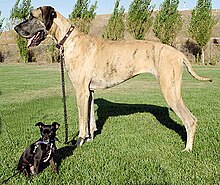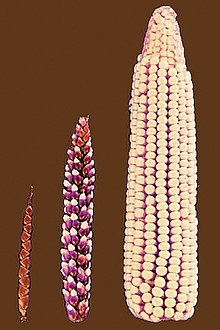
Back Selección artificial AN اصطفاء اصطناعي Arabic Seleición artificial AST Süni seçmə Azerbaijani Изкуствен отбор Bulgarian কৃত্রিম নির্বাচন Bengali/Bangla Selecció artificial Catalan زاوزێ پێ کردنی دەستکرد CKB Šlechtění Czech Kunstig selektion Danish
| Part of a series on |
| Evolutionary biology |
|---|
 |




Selective breeding (also called artificial selection) is the process by which humans use animal breeding and plant breeding to selectively develop particular phenotypic traits (characteristics) by choosing which typically animal or plant males and females will sexually reproduce and have offspring together. Domesticated animals are known as breeds, normally bred by a professional breeder, while domesticated plants are known as varieties, cultigens, cultivars, or breeds.[1] Two purebred animals of different breeds produce a crossbreed, and crossbred plants are called hybrids. Flowers, vegetables and fruit-trees may be bred by amateurs and commercial or non-commercial professionals: major crops are usually the provenance of the professionals.
In animal breeding artificial selection is often combined with techniques such as inbreeding, linebreeding, and outcrossing. In plant breeding, similar methods are used. Charles Darwin discussed how selective breeding had been successful in producing change over time in his 1859 book, On the Origin of Species. Its first chapter discusses selective breeding and domestication of such animals as pigeons, cats, cattle, and dogs. Darwin used artificial selection as an analogy to propose and explain the theory of natural selection but distinguished the latter from the former as a separate process that is non-directed.[2][3][4]
The deliberate exploitation of selective breeding to produce desired results has become very common in agriculture and experimental biology.
Selective breeding can be unintentional, for example, resulting from the process of human cultivation; and it may also produce unintended – desirable or undesirable – results. For example, in some grains, an increase in seed size may have resulted from certain ploughing practices rather than from the intentional selection of larger seeds. Most likely, there has been an interdependence between natural and artificial factors that have resulted in plant domestication.[5]
- ^ https://www.merriam-webster.com/dictionary/breed (Noun definition 1)
- ^ Darwin, Charles (2008) [1859]. On the Origin of Species By Means of Natural Selection or The Preservation of Favoured Races in the Struggle for Life (Reissue ed.). New York: Bantam Books. pp. 9–132. ISBN 978-0553214635.
- ^ Dawkins, Richard (1996) [1986]. The Blind Watchmaker: Why the Evidence of Evolution Reveals a Universe Without Design. New York: W. W. Norton & Company. pp. 7–11. ISBN 978-0393351491.
- ^ Boehm, Christopher (2012). Moral Origins: The Evolution of Virtue, Altruism, and Shame. New York: Basic Books. pp. 2–3. ISBN 978-0465020485.
- ^ Purugganan, M. D.; Fuller, D. Q. (2009). "The nature of selection during plant domestication". Nature. 457 (7231): 843–8. Bibcode:2009Natur.457..843P. doi:10.1038/nature07895. PMID 19212403. S2CID 205216444.